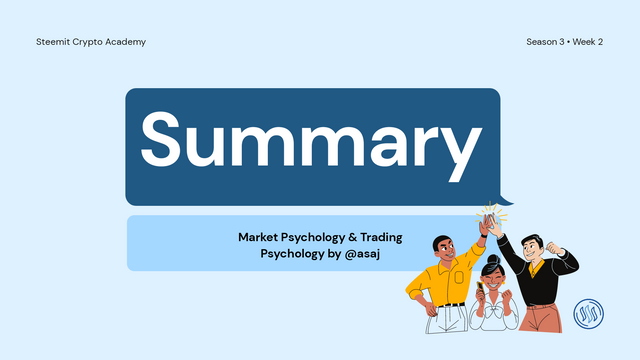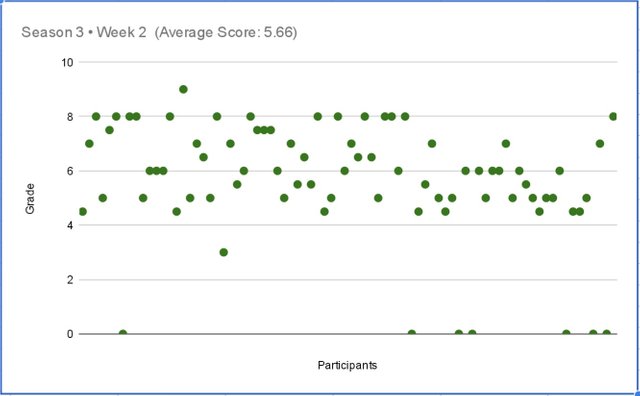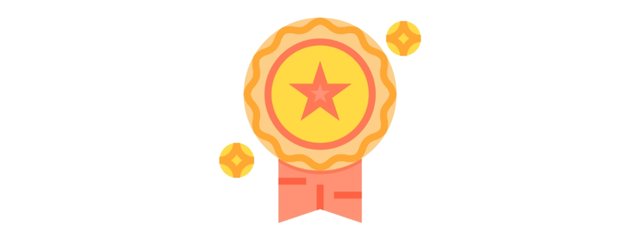Crypto Academy Season 3 | Homework Summary: Market Psychology & Trading Psychology
The second week of the Crypto Academy Season 3 has given us lessons we must bear in mind while trading crypto assets. I must say that I am quite pleased with the number of participants that completed the assigned task. However, we hoped they were more.
My assistant and I reviewed a total of 80 valid entries in the intermediate course. And we were strict with the grading process to encourage participants to demonstrate their understanding of the topic in a unique and presentable fashion.
We weren’t particularly looking for length; instead we focused on the depth of understanding, originality, quality analysis, and presentation that aligns with the global best practices. Interestingly, we were impressed with the entries of some students whose work stood out without a doubt.
This goes without saying that we appreciate the time and effort of all participants and we hope you find our suggestions helpful. Also, thanks to the Steemit Team for organizing an enabling environment for users to learn more about the crypto world.

What I Noticed
First and foremost, the number of unique entries caught my attention while reviewing the homework task. 93.7% of the total valid submissions were unique and which leaves us with just 6.3% plagiarized. The battle against plagiarism continues and we look forward to achieving 100% unique contents.
Participants displayed their understanding of market psychology and trading psychology. While the both forms of psychology involve state of mind of people, one precedes the other. Trading psychology focuses on the behaviour of a specific individual, whereas market psychology reflects the aggregate behaviour of people in the crypto market.
They were also able to identify several human errors in reasoning and in processing available information that often lead to poor judgment and irrational investment. Conclusively, they explained the assumptions of efficient market hypothesis.

The simple average score for submissions on #asaj-s3week2 tag stands at 5.66
In a bid to teach and emphasize the importance of trading and market psychology as well as how they affect the prices of crypto assets, a case study that depicts the reality of trading was prepared.
Ordinarily, it is a complex topic. However, the level of participation in the course shows that the case study provided a good explanation of the terms we discussed.
To assess how participants understood the course, the following questions were asked:
Part A (Case Study)
The case study given is an example of what type of psychology? Explain the reason for your answer.
Using the case study above, list and explain at least 5 biases that influenced Jane's trading behaviour with examples of how it affected her behaviour?
List and explain how each bias you have mentioned can be avoided?
Part B (Research & Analysis)
What type of analysis can be used to monitor market psychology and trading psychology, and why? Identify the differences between trading psychology and market psychology.
How can you measure market psychology using a crypto chart? Select 5 trading biases and explain with screenshots of any cryptocurrency chart how the biases can cause a coin to be oversold and overbought. (Add watermark of your username)
In your own words, define the term efficient market hypothesis (emh). List and explain the advantages and disadvantages of efficient market hypothesis (emh).
In general, participants answered most questions correctly. Nevertheless, the fifth question was made to serve as a verification task of PoB which tested the technical ability of participants.
My Recommendation to Participants
After going through the submissions I discovered that some participants could have scored higher had they followed these suggestions:
- Understand the question before writing an answer. While answering Question 5, only a few students were able to explain the concept of overbought and oversold conditions using technical indicators (such as RSI, MFI, Bollinger Bands and others). Simply mentioning these indicators without using them will not earn you the full marks in that question. These market conditions tells us the current psychology or behaviour of the traders in the crypto market.
- Also, our discussion about trading and market psychology will be incomplete without the mention and use of greed and fear index. The greed and fear index gives us an idea of how traders are conducting themselves in the market. When the indicator reads extreme fear, it means traders are panic-selling their positions which often cause assets to become oversold. Thus, driving the asset's price downward.
- Let us talk about screenshots. When it comes to uploading images and screenshots of graphs, one has to be careful especially if the screenshot is taken on a mobile phone. Mobile phones are often used in portrait mode. The resulting screenshots taken from these phones would also be in portrait view. The drawback is that such screenshots cover large surface area of the screen when reading your submissions. This leads to poor user experience when reading your post on PC and mobile. Hence, it is advisable to crop or resize such screenshots. Better yet, you can toggle your phone to landscape mode before taking a screenshot.
Presentation style matters a lot. There is more to writing an article than just piling up words without proper content structure. First, group similar contents under a heading, then structure them into subheadings by using lower level heading codes. A paragraph should contain 50 to 90 words. You can use the
<hr>code as a divider or upload a .png or .jpg divider to seperate content between two high-level heading. Another way to improve the aesthetics of your work is to apply the html justify tag.Originality is the key. One student mentioned that his work is over 2000 words and as such he deserves a 10. Well, we sincerely appreciate participants who put so much effort in writing an elaborate post. However, our focus isn't on the length of the article but on amount of new information that is contributed to the bank of knowledge of the academy. We do not want a case where participants write on the same thing over and over again. For instance, we talked about bias last week and there are over 20 biases that affect the human nature. Why not write on 5 that no one else (or only a few persons) have written.
- Add your personal touch. One easy way to make your work stand out is to include your personal experience. Use practical examples to explain the points you are trying to make.
In all honesty, one article will not be enough to explain what it takes to be a good writer. Practice, as they say, makes perfect. Therefore, as you continue to participate in more courses, you will notice gradual improvements. Emphasis on gradual because learning is a gradual process.
Homework Statistics (S03 • W02)
Before we delve into the statistics of submissions let us take a quick look at how they are categorized.
Quality Scale
The homework task are grouped using the following scale:
- Distinction: 8 to 10
- Good: 6.6 to 7.9
- Average: 5 to 6.5
- Below Average: 0 to 4.9
With that in mind, let's analyse the grades of entries.
Grade Analysis
Of the 80 valid entries, 10 participants made distinction, 12 did a good job, 37 had an average performance, 11 did below average, while 5 participants submitted plagiarized content. Here is a bar chart that shows this:

Additionally, the doughnut chart below presents the data in percentage.

| Distinction | ||
| Good | ||
| Average | ||
| Below Average | ||
| Plagiarism | ||
Post of the Week
We want you to know that it wasn’t as easy task to select three out of the many quality articles that was submitted. The academy promotes healthy competition that seeks to improve the quality of submissions.
We hope this encourages you to work harder in order to earn a spot in the post of the week. That said, if you have participated in the assignment you are a winner. Maybe not today, but someday you will be. However, here are homework post of the week (July 5th to 10th):
 |
| Provided unique answers and displayed a remarkable understanding of the topic. Becky's submission contained a combination of lessons taught by other crypto professors that are relevant to the homework. This portrayed the depth of her understanding. |
 |
| Analysed the case study to extract information about the subject's trading behaviour, opportunity cost and suggested the best possible solution. Donjosuexd also utilized multifactorial indicators to conduct crypto market sentimental analysis. |
 |
| Demonstrated a clear understanding of the topic by presenting practical steps on how to use MFI, MACD, and RSI to monitor market psychology. Oluwatobiloba's work was a good mixture of research and practical application. |
We had a good time reading all your quality contents and it is a pleasure to share our knowledge in the Crypto Academy. We look forward to see all your quality posts in the coming weeks.
Final Words
At the end of the day, it isn’t all about what you know but how well you express yourself. Mode of delivery is just as important as the knowledge you choose to deliver. Using complicated words often do not yield the best results. The primary purpose of communication is to express, not impress.
Hence, we encourage you to organize your work in a logical format and use simple terms to express yourself. You do not have to copy anyone. Be yourself! Don’t say that because one user answered a question in a certain way so you must do the same. No! Be yourself and your work will stand out.
We are building a community that fosters engagement through educative content. Like every successful community, it takes collective effort and cooperation. Remember that no one is perfect, we all need correction (myself included) to become better. So let us learn together.
Thank you professor @asaj.
amazing!!! thanks a lot
I will try to impress you next time. Smiles, I have to. It seems you are a hard man to impress but I will try my very best.
Congrats to the top 3.
I am overwhelmed with this mention. Thanks a lot professor, I surely hope to improve continually